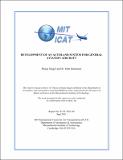| dc.description.abstract | Accidents due to engine failure, pilot disorientation or pilot incapacitation occur far more
frequently in general aviation than in commercial aviation, yet general aviation aircraft are
equipped with less safety-enhancing features than commercial aircraft. This thesis presents
the design of an emergency autoland system that includes automatic landing site selection,
guidance to the selected landing site and guidance along the final approach, in addition to
the automatic landing capability provided by conventional autoland systems. The proposed
system builds on the capability of a general aviation autopilot, flight management system and
GPS/WAAS augmented, integrated navigation system. The system provides this automatic
landing capability without the use of automatic throttle control and without the use of
a radar altimeter, which are essential to conventional autoland systems, but are typically
lacking on general aviation aircraft. The design addresses the challenge of no automatic
throttle control by utilizing only two simple power settings: cruise power and zero power.
The lack of radar altimeter is addressed by appropriate flare planning and placement of the
target touchdown point. The approach from the point of autoland initiation, to the approach
fix at the the landing site, is performed at cruise power, provided that power is available.
The final approach from the approach fix to touchdown, is performed at zero power. Control
of the touchdown point location during the final approach is achieved through adjustment
of the length of the trajectory, whenever the aircraft’s glide performance deviates from the
expected performance. The aircraft’s glide performance is measured online as the aircraft
tracks the planned trajectory. The performance of the final design is evaluated in simulation
in terms of touchdown point dispersion, sink rate and attitude on touchdown. | en_US |
